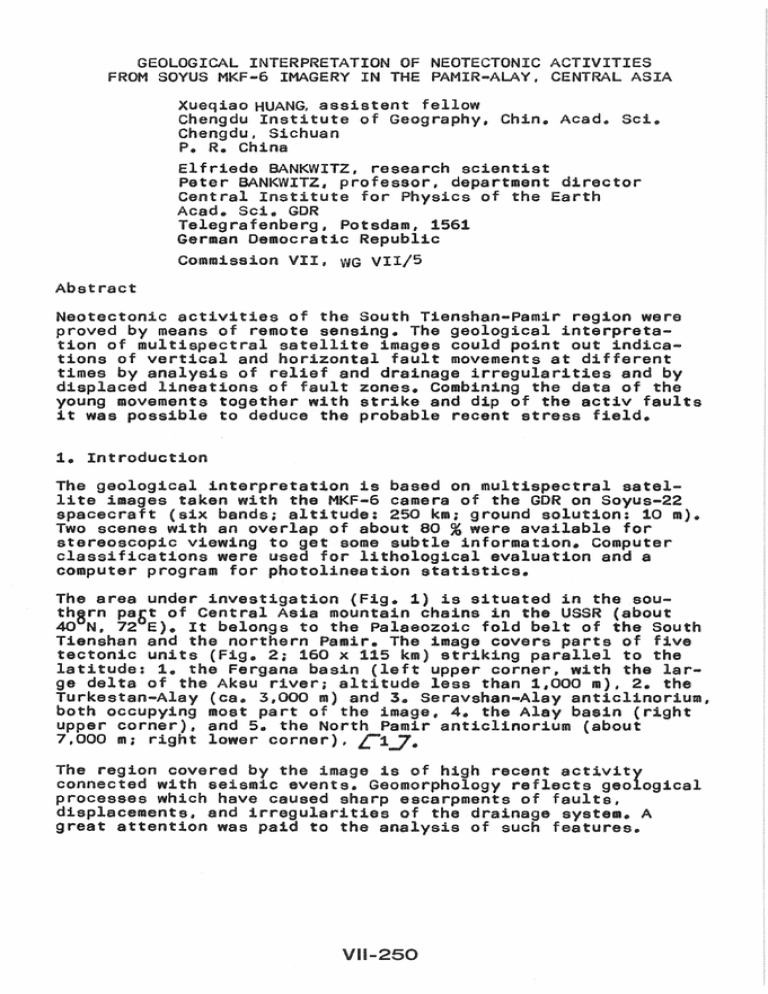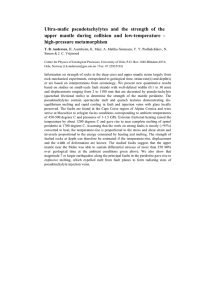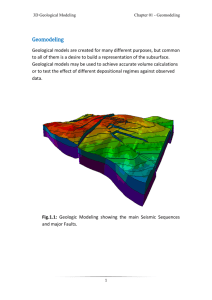GEOLOGICAL INTERPRETATION NEOTECTONIC ACTIVITIES
advertisement

GEOLOGICAL INTERPRETATION NEOTECTONIC ACTIVITIES FROM SOYUS MKF-6 IMAGERY IN THE PAMIR-ALAY, CENTRAL ASIA Xueqiao HUANG, assistant fellow Chengdu Institute of Geography, Chin. Aced. Sci. Chengdu, Sichuan P. R. China Elfrieda BANKWITZ, research scientist Pater BANKWITZ. professor, department director Central lnst ute for Physics of the Ea Acad. • GDR Telegrafenberg, Potsdam, 1561 German Democratic Republic Commission ,WG 1/5 Abstract Neotectonic activities of the South Tienshan-Pamir region were proved by means of remote sensing. The geological interpretation of multispectral satellite images could point out indications of vertical and horizontal fault movements at different times by analysis of relief and drainage irregularities and by displaced lineations of t zones. Combining the data of the young movements together with strike and dip of the activ faults it was possible to deduce the probable recent stress field. 1. Introduction The geological interpretation is based on multispectral satellite images taken with the MKF-6 camera of the GDR on Soyus-22 spacecraft (six bands; altitude: km; ground solution: 10 m). Two scenes with an overlap of about 80 % were available for stereoscopic viewing to get some subtle information. Computer classifications were used for lithological evaluation and a computer program for photolineat1on statistics. The area under investigation (Fig. 1) is situated in the southsrn past of Central Asia mountain chains in the USSR (about 40 N, 72 E). It belongs to the PalaeOZOiC fold belt of the South Tienshan and the northern Pamir. The image covers parts of five tectonic units (Fig. 2; x km) striking parallel to the latitude: 1. the Fergana basin left upper corner, with the large delta of the Aksu river; a ude less than 1,000 m), 2. the Turkestan-Alay (ca. 3,000 m) and 3. ravshan-Alay anticlinorium, both occupying most part of the image, 4. the Alay basin (right upper corner), and 5. the North Pamir anticlinorium (about 7,000 mi right lower corner), ~1-7. The region covered by image is of high recent activ1tr connected with seismiC events. Geomorphology reflects g80 ogical processes which have caused rp escarpments of faults, displaceMents, and irregularities of the drainage system. A great attention was paid to the analysis of such features. Fig. 1 Location of the study area 1n the southern part of Central Asia (USSR). The image includes the South Tienshan (Aley) and the northernmost Pamir. Numbers: see in the text. MKF-6 image from Soyus -22 spacecraft, band 4, 18.9.76, Pamir-Alay (see Fig.i). Explanation of numbers 1n the text. Fig. 2 2. Geological interpretation Only a few rock outcrops with lithologic si~nificance occur in the study area. The best examples for lithologic evaluation are the dark stripes of anticlines at the boundary of the Fergana basin, according to the geological map coal bearing beds of Devonian age. and the light stripes of Quaternary age in the Fargena basin and light areas in the Alay valley and other ones. But the white band at the northern border of the Alay valley show the highest reflectance. It belongs to Palaeogene marine sediments. The neighbouring darker stripe represents red continental sediments of Lower Cretaceous age. On the color composite VII 1 o 8 16km\ --1---1-'- , - - , ' L...' Q Fig. 3 Photogeological map on the base of satellite images (Fig_ 2) checked by the geological map. Legend Q N-Q N ~ K J T-J T P-T p c-p C C2 -C 3 C1 -C 2 C1 Quaternary Neogene-Quaternary Neogene Palaeogene Cretaceous Jurassic Triassic-Jurassic Triassic Permian-Triassic Permian Carboniferous-Permian Carboniferous Middle-Upper Carbon. Lower-Middle Carbon. Lower Carboniferous o-C 0 O2 03 °1- 02 5 V V V V V + + + + + + ++++++++ +...+...++++ x x x X 'X V'- EJ '. '. ~ ........ ~ ........."e.. ••••.. :: VII ... 252 Devonian-Carboniferous Devonian Middle Devonian Upper Devonian Lower-Middle Devonian Silurian effusive rock or tuff granodiorite syenite granite lithological boundary inferred lithological boundary lithological traces dipping glacier or snow they occur as small yellow-brown and white bands. There were some difficulties to distinguish continental Neogene sediments from Quaternary sediments if we only use color information. But comprehensive analysis of texture and drainage pattern, and position information still provided the possibility to delineate some of them. For the other parts of the mountain area it is necessary to lay more emphasiS on integrating color composite, texture pattern and other information because of the well-known dependence of the type of erosion, relief, and drainage pattern on the properties of the rocks L-2,3-l. The geological interpretation was checked by the geological map. Generally,both are coinciding. Some of the rock units are not suitable to be interpreted from the image. After comparing some parts were reinterpreted. The final result is shown in Fig. 3. Apart from Visual interpretation a supervised and a unsupervised classification were used for lithologic evaluation. With the images of the bands 1, 2, 6 was carried out a Bayes maximumlikelihood classification (15 classes) to complete the geological 1nterpretation~ Fig. 4 Interpreted drainage map on the base of a satellite image (Fig.2). Arrows indicate faults or inferred faults. VIl . . 253 3. Photolineations Many photo11neations are to be seen distinctly in the hard rock, mostly crossing the mountain chains oblique with a small angle, sometimes they occur parallel to the mountain crest (Fig. 2 and 5). They are forming sharp escarpments, first of all at the border to the Fergana basin (left upper part of the image) indicating neotectonic uplift of blocks. At some places these fine linea of fault traces are running down from the mountain crest to the lower plateau crossing there the large fans on the slope. They are dominantly striking E-W and cutted by younger NW and NE faults which have produced displacements of the older e-w fault traces. The displacements amount to some hundred meters (200 to 800 m) and are mostly to be recognized in the northern part. They seem to be caused by horizontal movements, compared to it the fault escarpments point out vertical movements. The steep dipping e-w faults preparing steps in the relief are sometimes indicated by as~metrical drainage pattern (Fig_ 4). In many cases the drainage reflects fault tecto- Recent movements -! vertical :::: horizontal Fig. 5 Simplified lineation map of Pam'ir-Alay area. Arrows: supposed movement direction. , t o r de rma , too. For , drainage in the conjunction area of the Saravshan-Alay, Alay valley and no rn Pamir is va and sups different directions of tribute s and lineations ( • 4, middle to the right hand). Such pat rn indicates manifold deformation ~2-7 and probably k-layered metamorphic rocks L-4J. The photo11neat1ons belong to two sIstema: 1. E--W/N--S, 2. NE/ NW. They coincide with the main feu ts of the geologic map, but there are many additional lineat reflect unknown faults. of t seems to of • rection rose diagrams for tee unit and r the whole studied area obtained by a computer program demonstrate the dominance of e--w lineat ( . 6). Their extension va from 20 up 150 f rent rameters characte behaviour of fault s are 1. Length frequency length o frequency length o frequency 90 o o. o WHOLE AREA b. o FERGANA TURKESTAN -ALAY o o ----90 d. Fig .. 6 SERAVSHAN-ALAY Rose diagrams frequencies e. ALAY VALLEY f. NORTHERN PAMIR area. Lengths and HUANG 1987 no. F * direction 85 0 1 1~-"'g~th----typ~~---~-fXX---r~i1ef (km) movement 40 V indication fault trace scarp displacesingle or shape of relation ment amount complex the zone (older/ <Jitl___ l1nes_tiJlnyounger) 5 displace.: single slight 1 / 800 F 3 curve 2,3,4,5 400 F 2 600x2 F 4 300 F 5 F F F F < F 14 10 H 0 8+7 H 5 40° 3 H 6 85 0 38 V 2 40° 3 4 125 0 145 H I displace- ment of scarps fault trace scarp N 01 9 displace.: 500x2 F 11 800 F 10 400x2 500 500 m F 7 85 0 24 V F 8 80° 20 V F 9 1420 4+2 H 10 0 4+4 12+10 H F F Table 1 155 130 0 H fault trace scarp fault trace scarp displacement of scarps F single single 2 parts single straight straight straight straight 3 parts straight 9 F 12 F 13 2 parts 4 parts 2 parts straight straight straight Parameters of selected recent active faults in the Pamir-Alay. * see Fig. 5; ** V - vertical movement, H - horizontal movement. 6,(7,8?)/ 9,10,11. 12,13 no. diraction length (km) 45° 6 H 6 H 20 V F F 138 0 85° F type of** movement relief indication -d-:1~~pi~-~-~-~--------~-:i.ngi~;-o~---- sh~pe of ment amount (m) displace- :~:;:sof fault trace scarp 4 displace.: 2000 F 15 400 500 400 F 48° 6 H F 16 48 0 5 H F 55° 6 H F 55° 8 H F 90° 46 V 45° F 6+5 H F 48° 15 H F 0° 36 H F 9So 1 22+26 H 6 displace.: SOO F 20 displacement of scarp valley the zone straight st t single slight curve single (double?) s1ngle ra at ** 14/15. 17,18 t t single single straight straight single straight 2 parts (1) straight lines straight t curve ra t 2000 F 22 single single 400 F 24 2 rts Parameters of selected recent se faults the Pamir-Alay. see Fig. 5: V-vertical movement, H-horizontal movement * relation (older/ younger) F 16 F 17 F 18 displacemente of scarps fault trace scarp complex lineation single single 19 / 20 21 / 22 23 / Analysis of Neo c Ac t s The satellite image contains me format nature about recent and neotectonic endogenous ee reflected by the landscape features. The high ero rate together with the high young relief imply the sting uplift of the Alay and Pamir mountains. Large fans with erosion deb at the footwall of the fault escarpments cover sometimes the whole slope and the steplike plateaus parallel to the faults, because there is no water enough to transport the debris down to the lowland (Fig. 2). That means, the mountaneous be drowned in its own debris, caused by the rmanent uplift of the mountain chains. In the conjunction area of r and the Sa to the west of the Alay valley a rns, ues, and tarns are to be recognized beyond snow line. But phenomena could not been found in other part of the image. This might indicate the continual subSidence of this part in recent time and the area may be a prolongation of the subsided zone of the Alay valley. Neotectonic activities have a strong t wi geomorphological processes and appearance study area proved by the steep dipping fault scarps of the ft upper part of the image (Fig. 2). They are notable image features clearly displaced by oblique younger faults with horizontal movements. Because there is a strong physical weathering in the area ~3-7, so this features prove that the dip-slip faults are active recently. That means uplift going on rwise the steep re f must be • River valleys in this area are immature, so some drainage pattern anomalies indicate neotectonic activ1 by the aaymmet position of the drainage tributaries (Fig. 4 ). Such pattern is an indication of the occurrence of horizontal sliding parallel to the main valley C1 7. The direction of the tributaries does not follow the naturar flow direction. They are shifted to the higher terrain against the graVity, and they point out influence of acting faults. The transcurrent faults 9 sib1lity measure or estimate some neotectonic activity (Fig. 5, Table 1). On sa of these s it to suggest that there are two recent active fault system in this area. Vertical movement is significant r e--w striking ts. horizontal movement characterize NE-SW striking faults (left-handed shearing) and the MV-SE t8 right-handed shearing. A horizontal compreSSion in north-sou dirac should have eXisted in this area during the neotectonic development up to recent time. This stress field deduced from the remote sensing interpretation oorrespond to the northward overthrusting Pamir, and to several focal plane solutions of seismic events this region ~1-l. 5. Conclusions The studied area is characterized by complex geological structures and varied geomorphology. For such area, the high spectral and spatial resolution of Soyus MKF-6 imagery is favourable for geological interpretation. Available stereoscopic pair images also sharpen ability of interpretation. In such area characterized by strong physical weathering, erosion patterns with strong correlation to rock properties provide Vital information. Integrating direct image information as geometric feature~ color, texture, and drainage pattern enable additional indirect geological information in regard to delimitation of units and different rocks, and kinematic analysis. The area under investigation is of high recent activity proved by seismiC events. Many indications of neotectonic activities have been interpreted or inferred from images based on interpretation of geological features, lineations and drainage pattern. Some parameters of neotectonic activity have been measured or estimated. Vertical movement for E-W striking faults and horizontal movement for NE-SE and NW-SE striking faults were derived by analysis of kinematic indications. It is to suppose that recent horizontal compression in north-south direction exists in the area and the superordinate stress field can be derived corresponding with the interpretation of seismic events. References BANKWITZ. p.: Partir-Alai.-In: Atlas for the Interpretation of Multispectral Aerospace Images (Methodology and Results). - Academy-press. Berlin# Nauka-Press, Moskau, 1982, p. 65-68 BANKWITZ, P.; Problem-oriented interpretation of satellite images.- Veroff. Zentralinst.Phys.Erde, UNO Training Course "Remote Sensing Applications to Geological SCiences·, Potsdam 1987, p. 93-116 SUSLOV, S.p.: Physical Geography of AsiatiC RU8sia.W.H. FREEMAN and Company. 1961 A.D.: Drainage Analysis in Geologic Interpretation: a SU.mat10n. - The American ASSOCiation of Petroleum Geologists Bulletin,v.51, (1967)11; p. 2246-2259 H~VARD, VU . . 259





